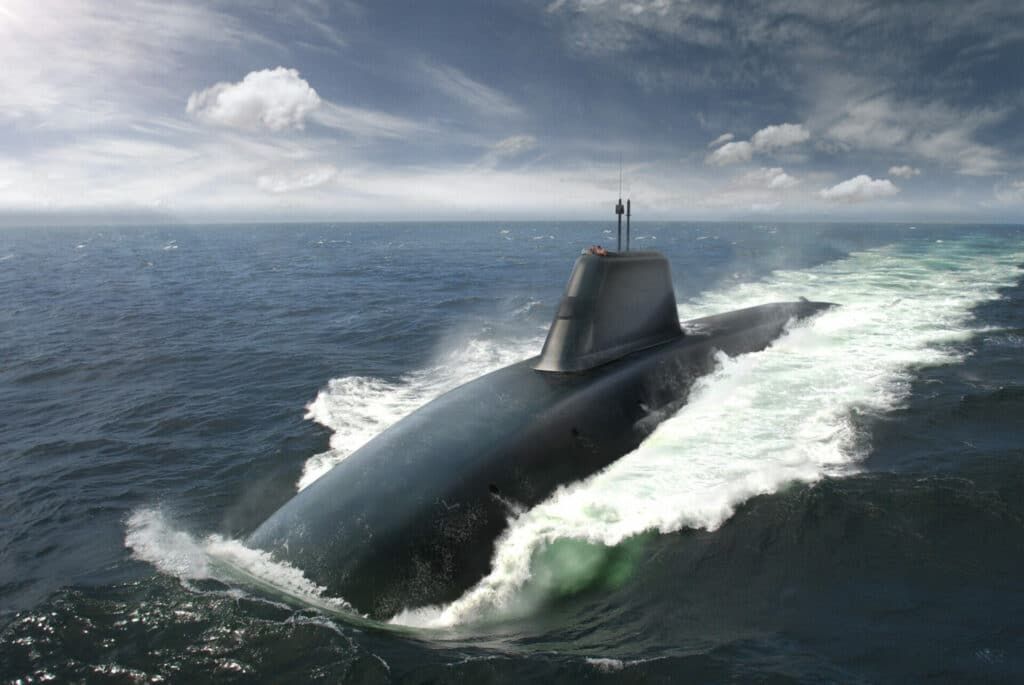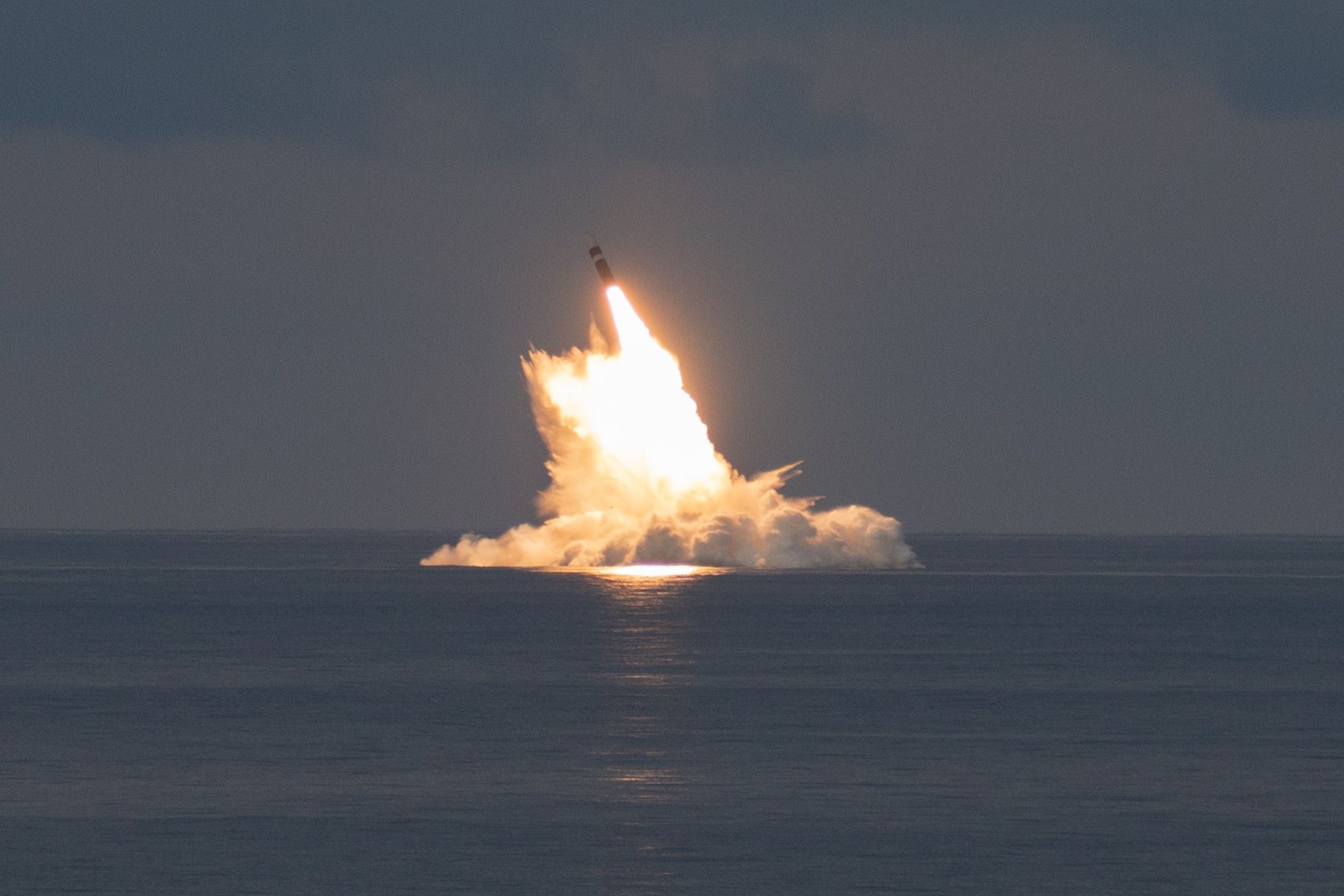America’s new multibillion-dollar nuclear warhead is a great deal for the British
By Shane Ward | April 14, 2022
 Artist's impression of the Dreadnought-class submarine. Credit: UK Ministry of Defence
Artist's impression of the Dreadnought-class submarine. Credit: UK Ministry of Defence
According to the US Stockpile Stewardship and Management Plan released last month, the development of the United States’ first new nuclear warhead since the Cold War appears to be proceeding. Collective sighs of relief are emanating from Washington and London. But they may be louder in the United Kingdom.
Last October, despite resistance from Democrats, the US Senate Armed Services Committee authorized $134 million of 2022 funding for the W93 submarine-launched ballistic missile warhead and the Mark 7 aeroshell re-entry body for the Trident II D5 missiles that will carry it. The Energy Department has been vague in describing the W93, referencing it as a new “program of record” rather than a new warhead. The new stockpile plan lays out a more detailed and accelerated timeline for the W93, but remains ambiguous in regard to details, saying the program offers the Navy a “modernized warhead capability” that “incorporate(s) modern technologies… to address future threats.” The warhead apparently is intended to ensure continuity, replacing older W76 and W88 warheads as they are phased out of service.
The United States’ need for the W93 is not as urgent as the timeline suggests. Both existing warheads have recently undergone costly modernization and life-extension programs and seem likely to remain in deployment for many years, and perhaps decades.
The program’s urgency seems attributable to the United Kingdom’s nuclear modernization efforts. The Royal Navy is undergoing a sweeping renewal of its nuclear forces, including the construction of four new Dreadnought-class submarines. Part of the long process reaffirmed in an update to Parliament late last year involves the delivery of a new British warhead “in parallel with the US W93/Mk7 warhead program.”
It ought to come as no surprise that Washington and London are cooperating on the new warhead program: The two countries use identical Trident II D5 missiles from a common pool located in King’s Bay, Georgia, which makes warhead compatibility essential. But the partnership is raising questions about Britain’s sovereignty and who is footing the bill for the W93.

Unfounded urgency. Over the course of 25 years of studies, engineering, and production, the W93 program may cost up to $14 billion, with production of the first warheads expected between 2034 and 2036. The case for embarking on the program was made in the latter days of the Trump administration; its urgency remains open to question. The Navy has spent large sums modernizing the submarine-launched ballistic missile warheads the Navy now deploys on its 14 Ohio-class submarines, the W76 and W88. One prevailing reason for the new program is the Navy’s numerical reliance on the older, lower-yield W76-1 and W76-2 warheads, at 90 kilotons and 8 kilotons respectively, which outnumber the 455-kiloton thermonuclear W88 by almost five to one in the arsenal. An unclassified white paper from 2020 suggests the W93 would likely offer a variable- or at least higher-yield alternative, diversifying the Navy’s warfighting options by allowing it to “hold all targets in current plans at risk.”
Obvious overlap between the US and British programs ends with the Trident missiles. But circumstances around the W93 program suggest more than meets the eye. London needs a new warhead more than Washington does; not only does the United Kingdom rely solely on its nuclear submarines for its deterrent, lacking intercontinental ballistic missiles and bombers like those of the United States, but it has also never deployed the W88—relying exclusively on the older W76, or Holbrook warheads, as they are known.
“Very significant implications.” The British government has insisted on its country’s nuclear sovereignty since it first developed its deterrent, but poor management and expensive delays have damaged this claim in recent years, while previous indigenous programs have failed. In a 2020 House of Commons Defense Briefing, then-Permanent Secretary of the Ministry of Defence Sir Stephen Lovegrove admitted that British funds for a warhead replacement would run out in four years, adding that uncertainty in Washington about the program would have “very significant implications” for the United Kingdom. Allegations that the W93 was more for the British than the American deterrent were not helped when it emerged that British Defence Secretary Ben Wallace had directly lobbied members of Congress to support its funding in 2020.
US officials have not helped either, reiterating in the recent stockpile plan that the W93 program was “also vital for continuing our longstanding cooperation with the United Kingdom,” whose “nuclear deterrent is critical to US national security.” Warhead programs are costly and take decades of research and development, but there are real concerns the W93 is not an urgent need for the Navy. Chair of the House Armed Services Committee Rep. Adam Smith suggested as much, noting that the program “may arguably be a little bit ahead of need” and that “the UK is pushing a lot of that.” The question for lawmakers is therefore the inherent value of the British deterrent to US national security, especially for a program the United States does not need and for which it appears to be footing much of the bill.
The war in Ukraine has seemingly reaffirmed the Biden administration’s commitment to its NATO allies, with the recent Nuclear Posture Review summary also ruling out a no-first-use policy long opposed by many allies in Europe. In this case, however, even the long-held nuclear cooperation between Washington and London does not justify the development of the first new nuclear weapon in decades.
The cost of the W93 program and the urgency with which it is being pursued have not yet been justified. The United States should not rush to design and build a symbolic new warhead for the arsenal of an ally, even one as close as Britain, when Congress has so far failed to build a case for it on much more than British interest alone.
As for London, the Ministry of Defence has built an equally unconvincing case and, perhaps worse for its security, one that exposes a deep reliance on an ally for its supposedly independent deterrent. The war in Ukraine and heightened tensions with Russia must not dictate unnecessary modernization spending.
Together, we make the world safer.
The Bulletin elevates expert voices above the noise. But as an independent nonprofit organization, our operations depend on the support of readers like you. Help us continue to deliver quality journalism that holds leaders accountable. Your support of our work at any level is important. In return, we promise our coverage will be understandable, influential, vigilant, solution-oriented, and fair-minded. Together we can make a difference.
Keywords: Royal Navy, W93, sovereignty, warhead
Topics: Nuclear Weapons, Opinion, Voices of Tomorrow















Fascinating. Well written article. A well-placed congressional staffer told me that the UK has a “parts problem” for its existing W76s. A completely new warhead design is like using a sledgehammer to nail a tack. A parts problem is solvable. My own conjecture is that it involves nonnuclear components that can be relatively easily supplied by the Kansas City National Security Complex, which is known to have supplied the UK with nuclear weapons parts in the past. The U.S. designing and building a completely new design warhead for the Brits is crazy. First, as you noted, the U.S. government has… Read more »
Thank you for the interesting additional comments, Jay! You’re right– so much to dive into here and just not enough space. $14 billion is the DoE’s upper estimate, and as you say, total costs are going to end up way above that if new pits are needed, another precedent broken. As a Brit myself, the absence of debate in Parliament on this new warhead and indeed the British nuclear deterrent at large is shocking. Even in the confines of the Mutual Defense Agreement, this whole thing reflects really poorly on our so-called nuclear sovereignty.
The original W-76 model 0 was designed and entered into production from 1973 to 1978. Many of the original parts for US nuclear warheads are no longer in production and were custom made for the specific application. Example – the resin used in some ablative re-entry vehicles is no longer made, because the original contractor went out of business. There is a specific wrench used for LGM-30G warhead and several USAF bases share one [yes, one!] wrench. It went missing once and created a crisis. (https://abcnews.go.com/Politics/us-wrench-nuclear-bases/story?id=26916107) When LeMay and Power ran SAC, this sort of nonsense did not occur. After… Read more »
Where are the new pits being built or old ones reprocessed?